|
The first Corvette was unveiled to the public at the 1953 General Motors Motorama car show. Soon thereafter, it went into production with the first car becoming available in June. With such a short model year production run, there where only 300 1953 Corvettes produced.
The outer body was made out of a revolutionary new composite material called fiberglass, selected in part because of steel quotas left over from the war. Underneath that radical new body were standard Chevrolet components, including the "Blue Flame" inline six-cylinder truck engine, two-speed Powerglide automatic transmission, and drum brakes from Chevrolet's regular car line. Though the engine's output was increased somewhat, thanks to a triple-carburetor intake exclusive to the Corvette, performance of the car was decidedly lackluster. Compared to the British and Italian sports cars of the day, the Corvette was underpowered, required a great deal of effort as well as clear roadway to bring to a stop, and even lacked a "proper" manual transmission. Up until that time, the Chevrolet division was GM's entry-level marque, known for excellent but no-nonsense cars. Nowhere was that more evident than in the Corvette. A Paxton supercharger became available in 1954 as a dealer-installed option, greatly improving the Corvette's straight-line performance, but sales continued to decline.
GM was seriously considering shelving the project, leaving the Corvette to be little more than a footnote in automotive history, and would have done so if not for two important events. The first was the introduction in 1955 of Chevrolet's first V8 engine (a 265 in³ {4.3 L}) since 1919, and the second was the influence of a Soviet emigré in GM's engineering department, Zora Arkus-Duntov. Arkus-Duntov simply took the new V8 and backed it with a three-speed manual transmission. That modification, probably the single most important in the car's history, helped turn the Corvette from a two-seat curiosity into a genuine performer. It also earned Arkus-Duntov the rather inaccurate nickname "Father of the Corvette."
The noteworthy addition of optional fuel injection became available in 1957. This new induction system first saw regular use on a gasoline engine two years prior on the Mercedes-Benz 300SL "Gullwing" roadster. Although the Corvette's GM-Rochester fuel injection system used a constant flow style fuel injection system as opposed to the diesel style nozzle metering system of the Mercedes' six cylinders, the system nevertheless produced about 290HP. The number was derated by Chevrolet's advertising agency for the 283HP/283 in³ (4.6 L) one hp per in³ slogan, making it the first production engine in history to reach 1 hp/in³. In 1962, the GM Small-Block was enlarged to 327 in³ (5.4 L) and produced a maximum of 360 hp (268 kW). Other early options included Power windows (1956), hydraulically operated power convertible top (1956), four speed manual transmission (mid 1957, and heavy duty brake and suspension option (1957).
- The original front emblem and horn button on the "Autorama" show circuit Corvette featured crossed American and checkered flags. It was later discovered that using an American flag on a product trade mark was against the law and the emblem was changed shortly before the New York Motorama.
- On Tuesday, June 30, 1953 Corvette #1 Serial Number E53F001001 rolled of the assembly line, and Corvette production began.
- Want the rarest Corvette? In 1953 the first two Corvettes, VIN Numbers 1 and 2 were said to have been destroyed, but no records prove that fact and there are no witnesses to the destruction. Who knows? They still might be out there somewhere.
- The first Corvettes were literally "rolled" off the assembly line. The early production line was not prepared for grounding to a fiberglass body and thusly the first cars would not start.
- The first five Corvettes to come off the assembly line did not have an outside rear view mirror.
- Its radical fiberglass body was the only really new component on the 1953 Corvette. Everything else was directly off the Chevrolet parts shelf. Because of this, the first Corvette was essentially a regular 1952 Chevrolet under the skin.
- Of the 300 (some sources argue 314) Corvettes hand built in 1953 only 183 were sold because of "average" performance at a relatively high price, $3513. The popular Jaguar XK120 sold for $3345; $168 less than the Corvette.
- 1953 Corvettes were offered in any color you wanted... as long as it was Polo White with Red interior.
- A heater and an AM radio were the only Regular Production Options (RPO) offered with 1953 Corvettes.
- Production moved to the St. Louis facility for the 1954 model year.
- New 1954 exterior color options of black, blue, and red were added along with an optional beige interior choice.
- Although the Powerglide transmission was listed as a $178 option, no 1954 Corvette was ever shipped with a manual transmission.
- The 1955 Corvette finally achieved "true" sports car status with the introduction of 265 cubic inch, 195 hp V-8 engine and 3-speed manual transmission.
- To commemorate the new V-8 engine, 1955 Corvettes featured an enlarged, gold "V" in the "Corvette" script on the front fender panels.
- There are 13 vertical bars or "teeth" are in the grill of 1956 Corvettes.
- One of the few ways to differentiate between a 1956 and 1957 Corvette without opening the hood is to look at the inside rear view mirror. On the 1956 model, it adjusts with a thumbscrew, on the 1957 adjustment requires a wrench to loosen the locknut.
- The 1957 Corvette was the first mass produced American automobile to offer 1 horsepower per cubic inch of engine displacement (283hp/283ci).
- The "Polo White" color was last used in 1957.
- 1957 was the first year a limited slip differential and fuel injection were offered as options.
- For the first time since its introduction, the '58 Corvette came with factory-installed seat belts.
- 1958 was the last year of a tachometer which kept track of "cumulative engine revolution counter" a feature which first appeared in the 1953 Corvette. In 1958 the tach was used on 230, 245, and 250 hp cars but not on the 270 and 290 hp cars. The Part number is #1548631 for 1958 models.
- Optional engines in 1956 had 9 fin alloy valve covers, 1957 had 7 or 9 fin alloy valve covers, and the 1958 had 7 fin alloy covers on optional engines.
- Before 1958, the only acrylic lacquer paint used was on the "Inca Silver" Corvettes.
- 1959 was the only year that turquoise soft tops were available.
- Sun visors (called "sunshades") became a Corvette option in 1959.
- Nylon belted tires first became available on the 1960 Corvette, prior to 1960 only cotton ply tires were offered.
- The 1961 Corvette was the last year to feature "wide whitewall" tires.
- The 1961 Corvette dropped the "round" nose emblem of previous years in favor of the word "CORVETTE" spelled out as individual letters.
- The trademark chrome grill teeth disappeared forever in 1961, to be replaced by a fine mesh screen in the radiator opening.
- 1962 Was the last of the solid rear axle Corvettes and the last year for the power top on the convertible.
| Year |
Production |
Base Price |
Notes |
| 1953 |
300 |
$3,498 |
First year production starts on June 30; polo white with red interior is only color combination |
| 1954 |
3,640 |
$2,774 |
Production moves to St. Louis; blue, red, and black are added |
| 1955 |
700 |
$2,774 |
Both straight-6 and 265 in³ V8 engines produced; 3-speed manual transmission added |
| 1956 |
3,467 |
$2,900 |
New body with roll-up windows; V8-only |
| 1957 |
6,339 |
$3,176 |
283 in³ V8; Optional 4-speed manual and fuel injection added |
| 1958 |
9,168 |
$3,591 |
Quad-headlight body and new interior |
| 1959 |
9,670 |
$3,875 |
First black interior and dash storage bin; only year with a turquoise top |
| 1960 |
10,261 |
$3,872 |
Few changes from 1959 |
| 1961 |
10,939 |
$3,934 |
New rear styling, bumpers, and round headlights |
| 1962 |
14,531 |
$4,038 |
327 in³ V8 engine; last year with a trunk until
1999 |
| Total |
69,015 |
|
|
| Engine |
Year |
Power |
| 235 in³ Blue Flame I6 |
1953–1954 |
150 hp |
| 1955 |
155 hp |
| 265 in³ Small-block V8 |
1955 |
195 hp |
| 1956 |
210 hp |
| 1956 |
240 hp |
| 283 in³ Small-block V8 |
1957 |
220 hp |
| 1958–1961 |
230 hp |
| 1957–1961 |
245 hp |
| 1957–1961 |
270 hp |
| 283 in³ Small-block FI V8 |
1957–1959 |
250 hp |
| 1960–1961 |
275 hp |
| 1957 |
283 hp |
| 1958–1959 |
290 hp |
| 1960–1961 |
315 hp |
| 327 in³ Small-block V8 |
1962 |
250 hp |
| 1962 |
300 hp |
| 1962 |
340 hp |
| 327 in³ Small-block FI V8 |
1962 |
360 hp |
|
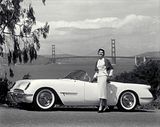
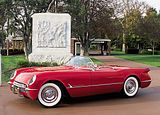
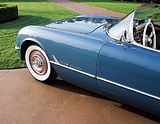


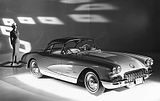
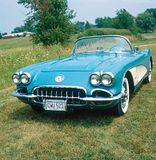
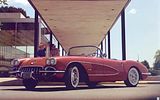
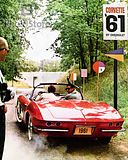
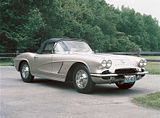
|